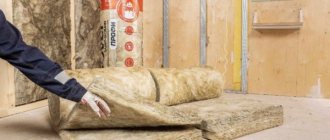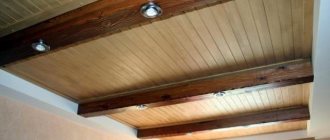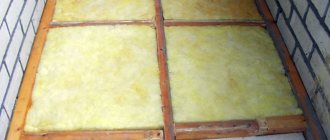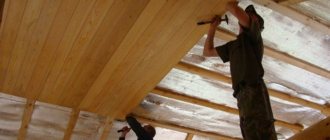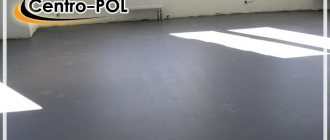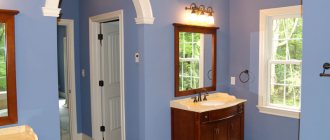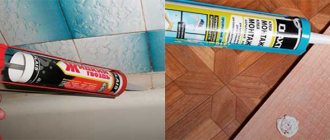assets/from_origin/upload/resize_cache/iblock/aa9/600_450_2/aa9484f6dd2ae750740684d0f631d4f9.jpg From this article you will learn:
- What options for finishing ceilings in a house are there?
- What are the features of finishing ceilings in a house with wood?
- How to make the ceiling in a private house unique in terms of design
- How to insulate a ceiling in a private house
- What should the ceiling be like in a private house, according to experts?
- How is the cost of finishing the ceiling in a house calculated?
What images come to your mind when you think about renovating the ceiling in your home? Most often it is “white and flat”. It is customary to finish walls or floors using the latest developments in design, and your imagination is not limited by anything. Unlike other interior details, ceilings are not given due attention during renovations. Finishing this part of the room is considered the simplest stage of work. But this opinion is wrong, and in practice, the unusual design of the ceilings of any room, be it a living room, study, kitchen, children's room or bedroom, gives the room originality and originality. In our article you can find detailed information about how ceilings are finished in a house.
Decorating the ceilings in the house with wood
Wood is considered a classic in home decoration, and is also successfully used in ceiling repairs. Eco-friendly wooden materials are often found not only in ancient interiors, but also in modern ones: from parquet and solid wood furniture to wooden wall panels, interior doors and baseboards. This design, developed in a natural style, is perfectly completed by finishing the ceilings in the house with wood. A stylish wooden ceiling will give you a feeling of coziness and comfort.
Wooden materials for finishing the ceiling in the house have a number of advantages:
- Scattering of light flux, which makes the room dark.
- Increased sound insulation of wooden ceilings.
The design of a wooden ceiling in a private house is determined by which room needs to be renovated. Thus, finishing with wood in the study will allow you to create a feeling of stability and seriousness, and in the sleeping area, a ceiling made of natural wood will make the room warm and cozy. Various methods of finishing the ceiling in a private house with wood depend on the functional purpose of the premises.
To decorate the ceiling in a private house, it is best to choose natural materials that will fit perfectly into the overall interior of the space.
So, finishing the ceilings in a house with wood is:
- lining;
- plywood;
- slatted panel;
- suspended wooden structure.
The most common finishing material is lining, which is a board of wood with a tongue and groove on one side and a tongue on the other. To assemble the shield, you need to connect the ridge with the tongue, which are inserted into each other.
Solid wood can undergo changes depending on the temperature or humidity in the room, so the seams between the lining boards tend to shrink and then increase in size. They are usually specially distinguished using a chamfer or rounding.
The lining can be thick, thin, and also narrow or wide. In addition, this material can be in the shape of a round log.
Recommended articles on this topic:
- Leveling the ceiling for painting
- Stages of renovation in an apartment
- Roof insulation with mineral wool
If you decide to finish the ceiling in a wooden house with your own hands using slatted structures, you can buy ready-made slats or order their production. In the latter case, you can choose any type of wood as a material for wooden slats. Moreover, you can determine the width of the slats.
When choosing a material for making wooden slats, it is recommended to choose the classics: poplar, elm, aspen. This will help reduce costs on purchasing materials. The use of several types of wood at once will give your ceiling originality.
Assembly of hydro- and vapor barrier
First, you need to decide what the room will be used for; if there is another heated room on top, then there is no point in installing heat and sound insulation on the sub-ceiling; wooden surfaces distribute noise and heat quite well. The vapor barrier is installed along the entire perimeter of the ceiling, especially well stretched in the corners, laid with an overlap, the boards are mounted overlapping. This will help protect the rough base and wooden ceiling from rotting and mold.
Ceiling vapor barrier - effective and high quality
Subtleties of laying insulation
If the insulation is installed incorrectly, it is possible to destroy the baseboards and decor, the rough ceiling, even cause a fire, for which you should slowly study the instructions so as not to confuse the sides, because the markings of different companies may contradict each other.
It is enough to cut circles of about 20 cm in the material around the planned lamp; this will create good fire safety, which is extremely important for a wooden house and wooden decorative elements. It is important to establish these places during the installation of the material - we measure the places from the wall, then put a mark on top, in the form of a circle with a diameter of 20 cm
Integrated thermal insulation reduces building energy losses
The same applies to vapor barrier, although the material is quite durable, but unstable to high temperatures, it can melt and lead to a fire, especially if the rough, facing and decor are made of untreated lining. Thus, an emphasized design can lead to dire consequences for the interior and the integrity of the room. But since the lamps and decor are not mounted to the sub-ceiling, like the wiring, it is enough to install heat-reflecting foil, 20 by 20 cm squares, on the vapor barrier below, at the mounting points. It will not be visible, but it will help preserve the interior of the room and not damage the intended design with decor.
Installing thermal insulation in a wooden ceiling
As we see, it is quite possible to make a wooden ceiling with your own hands quickly and efficiently. In addition, you can hem the rough base yourself, faster, better than many workers.
How to make the ceiling in a private house unique? designers ideas:
The interior decoration of the ceiling of a house in the modern sense is not just a flat white surface. Now designers are offering many ideas on how to decorate the ceiling in a private home, changing not only its decoration, but also its shape and design. Therefore, you can choose an option that suits your individual needs.
Ceiling lighting
Are you looking to create an unusual and stylish ceiling design? Then use LED spotlights in the decoration.
A variety of lighting techniques will allow you to create an atmosphere of original classics or catchy modernism in your home. There are many types of lamps, for example:
- chandeliers;
- candelabra;
- spots;
- LED strips.
Play with the depth of space
The increased interest among designers in finishing ceilings in the house is explained by the fact that thanks to this it is possible to visually increase or decrease the size of the room.
So, a ceiling in the shape of an arch or vault will visually make the living room larger and freer.
This decoration will create the feeling of a high ceiling, and the room will seem more spacious.
If your goal is to make the room smaller and more modern, then a sloping ceiling is perfect for realizing this idea. Moreover, among foreign architects and designers this type of ceiling decoration in a private house is the most fashionable trend.
Coffered ceilings are special structures: beams crossing each other, forming rectangles on the surface, which are additionally decorated from the inside. This type of ceiling decoration in the house will help create a.
The next method of interior finishing of the ceiling of a house is Tray Ceiling, which will also make the room larger, meeting the requirements of modern fashion. This technique uses drywall to create an “inverted or recessed tray.” Similar designs are also suitable for rooms with a standard ceiling height, but in houses with a high ceiling Tray Ceiling will look more advantageous.
Combining several techniques and styles.
By combining (even chaotically) spotlights on the ceiling, you will get the effect of sunlight in your home.
A large number of spots located in a certain order will help you:
- best illuminate the entire space;
- make the room cozy and rest in it comfortable;
- create an atmosphere of glow of natural sunlight.
To end up with a lot of sun glare on the ceiling, install several spots, abandoning the standard chandelier.
In addition to the fact that such a ceiling decoration will be visually advantageous, you will be able to save on energy costs, since such lamps have increased ergonomics.
Strengthening methods
Using steel plates you can strengthen beams
Steel auxiliary materials
Steel plates fixed on different sides of the beam will help strengthen wooden beams. Steel tools must be treated with a solution that prevents corrosion, otherwise they will not last long.
Carbon fiber
The material, also called carbon fiber, is a modern technology in the construction world and is actively used during beam ceiling reconstructions. It comes in the form of plates, ribbons or threads.
This plastic material is applied in several layers to a wood surface, ensuring ease of work and reliable quality, which makes it quite popular.
Prostheses made of wood or metal in the end areas
Due to variable temperatures, beams in the area of the load-bearing wall are significantly weakened. It is necessary to make the main timber beam stronger to prevent negative consequences in the future, as well as to avoid repeated reconstruction in the near future.
To do this, additional prostheses made of metal or wood are attached to the edges of the wooden base, which are placed in the brick recess of the wall, thereby providing reliable protection for the central beam.
Installation of prostheses for a rotten floor beam
Supports for load-bearing beams
This method involves placing additional support structures under the load-bearing ceiling beams to distribute the load evenly.
Additional beams
If the work is completed, but the weight is distributed incorrectly, then the finished structure must be covered with additional beams that will take on the excess weight.
It is quite possible to bring ceilings to life with your own hands, but to do this you need to familiarize yourself with the necessary information in order to minimize unpleasant moments during work, as well as build a high-quality model that will last for many years.
Insulation of the ceiling in a private house before finishing
Before you can begin the final finishing of the ceiling in the house, it is necessary to carry out insulation and vapor barrier.
Characteristic features of ceiling insulation in a house:
- The insulation layer is laid either using a rack method or using a construction stapler.
- Mineral wool insulation has better thermal insulation characteristics than expanded clay, fiberglass or foam.
- Installation of a frame ceiling requires the insulation to be located at the same level as the beams.
- In places where the chimney is exhausted, it is necessary to lay thermal insulation especially carefully (in private houses, the chimney usually passes through the attic).
- When laying mineral wool in layers, it is recommended to ensure that the middle of the slab of the first layer is located at the junction of the mineral wool of the second layer.
- The insulation should be covered with glassine, after which you can begin covering it.
When your house has an attic, there is no need to insulate the floor and ceiling. The voids can be filled with a mixture of sand, sawdust and lime to reduce sound transmission.
Operation of floors
If the design used beams with a large margin of safety, laid with a small step, then such an overlap will not need repair for a long time. But you still need to check the beams for strength regularly!
If the beams are damaged by insects or as a result of waterlogging, they are strengthened. To do this, the weakened beam is removed, replaced with a new one, or strengthened with strong boards.
I’ve been thinking for a long time about repairing the ceiling on my outbuilding at my summer cottage, but I still can’t get around to it. But here you need to seriously understand - I don’t really understand how the load on the beam is calculated if there are additional loads. We will need to seriously address this, most likely in the summer.
Nikolay, without special knowledge in the field of construction, you will not be able to correctly calculate the load on the beam. Too many factors and nuances need to be taken into account when making calculations. Believe me, it is practically impossible for a non-specialist to do this. First, try to at least determine the type and characteristics of the beam floors on your outbuilding. Even if you succeed, the work will stall at the calculation stage: the formulas (even their simplified versions) are too complex. My advice: leave the repair to professionals.
Good day. There is a wooden house, everything is clear to me about the first floor and floor. We'll most likely put a tarket or something similar. The second floor is only beams. A question arose for me: do I need to lay what kind of films? The house is residential, the second floor is residential. Or I’ll put insulation between the beams (since there’s some leftover, and it’s like sound insulation), and I’ll put a floor on top, a 35mm board. It seems to me that no films are needed.
General knowledge does not provide an understanding of approximate calculations of beam/floor load. Sofa + cabinet + table + 6 chairs, and 10 people = about one and a half tons - this is not a load. It’s another matter if you decide to place a brick warehouse on this floor. )
- How to lay tiles in the bathroom - step-by-step installation instructions
- Do-it-yourself laminate installation: rules and example of step-by-step work
- Installation of OSB boards - features of installation on a wooden and concrete base
Video about floor repair
We have put together a huge collection of video tutorials on repairing and laying floors
A collection of photographs showing floor design options and examples of using floor coverings
Frequently asked questions about finishing the ceiling in a private house
- What is the minimum ceiling height in a private house?
The lowest ceilings you can afford in a private house are 2.4 meters. Ceilings below this indicator will not be able to provide comfortable living: ceilings that are too low seem to put pressure on the residents of the house, and a person automatically wants to duck down.
- What height is best for ceilings in a private home?
In this matter, designers are of the general opinion that the higher the ceiling, the more advantageous it will look. So, even a small room, but with high ceilings, looks larger. However, it is worth considering that as the ceiling height increases, the cost of heating the home also increases.
According to all the laws of physics, warm air will rush upward, so in order to maintain the optimal temperature below, you will need to heat the air space under the ceiling to +30 +35 °C. Constant heating of the air at the level of the attic floor will lead to an increase in heat loss in proportion to the temperature delta outside.
You can avoid this by using the following solutions:
- Installation of convection heating, which uses radiators or convectors. This type of heating will allow you to limit the ceiling height to 2.7 meters, which will help maintain a balance between comfortable living and economical heating consumption.
- You can ensure optimal heating of a room with a high ceiling by making a heated floor (water, cable or film). This will create an acceptable temperature at the height of human growth, and the air near the ceiling will not overheat.
In two-story private houses, maintaining an optimal temperature is only possible with the help of heated floors, as well as using infrared heaters. Convection heating will not be able to provide normal temperature conditions on both floors.
- How can you make the ceiling higher?
In houses with panel or reinforced concrete floors, you can only increase the ceiling height visually, using design solutions.
For example:
- The use of light shades in the interior creates the illusion of distance between objects, while surrounding objects are highlighted in a contrasting color to further emphasize the difference between them. So, a white ceiling will look visually higher against the background of dark-colored walls;
- Increasing the ceiling height with the help of properly selected lighting. For this purpose, spotlights or spotlights are installed as hidden lighting.
You can also install ceilings under wooden beams, which will help you physically increase the height of the ceiling.
There is another, but more complex method - increasing the height of the ceiling. But here you will need to remove the roof of the house. Such manipulations are best carried out during roof repairs. Several rows of masonry are installed, or new frame crowns are installed, thus increasing the overall height of the walls.
The frame itself is supported by jacks: several crowns are driven under it.
Also, if the floor in your house is laid on wooden beams, you can remove them and lay the insulated screed directly on the ground. The disadvantage of this method of increasing the ceiling height is that the thresholds and windows of the house will become much higher than the finished floor.
Let's take a closer look at how the ceiling height is increased using this method:
- We dismantle the floor, flooring and insulation;
- cut off the beams;
- remove the soil and level it;
- we lay a sand (sand-gravel) cushion of 10-15 cm, which will act as drainage, and the soil above the floor will not freeze;
- waterproofing (polyethylene) is laid on top of the sand, overlapping the walls;
- on top of the waterproofing we lay a concrete pad 8–10 cm thick of low-grade concrete;
- then, when the concrete dries, we place insulation on it (expanded polystyrene, polystyrene foam, the density of which is c-35), and the thickness depends on temperature changes in your region. The standard thickness is 40-50 mm;
- on top, after another layer of waterproofing, we lay galvanized reinforcing mesh on stands 15-25 mm high (with a cell of 1-25 cm, wire thickness 5-6 mm);
- Fill the mesh with a screed 8-10 cm thick. Then we level the surface: lay plywood or self-leveling flooring. After this, you can begin laying the finishing coating.
Drywall (GKL)
A direct competitor to the previous option in terms of popularity is plasterboard ceilings.
One of their main advantages is complete environmental friendliness. Drywall does not contain harmful impurities, and therefore it can be safely used even to decorate the ceiling in children's rooms.
However, the material does not tolerate moisture well, absorbing it inside and becoming heavier. Therefore, if you are not confident in the moisture insulation of a wooden house or are choosing a ceiling for the bathroom, it is better to abandon this idea.
The variety of plasterboard structures allows you to use them in almost any interior style. Multi-level or single-level ceilings, arches and hanging elements... The use of drywall definitely leaves a lot of room for imagination.
Please note: Even more diverse design solutions can be found by combining drywall with tension fabric.
In addition, such a ceiling covers well all the imperfections of the ceilings and helps hide communications. If you need to hide a large pipe or panel, design a plasterboard box - it will look like an organic part of the interior, while reliably removing the unnecessary element from view.
The cost is also pleasing - plasterboards are considered one of the most inexpensive materials. This allows you to cover the ceiling of the entire house without particularly high costs.
However, there were some downsides. In addition to the already mentioned tendency to absorb moisture, drywall is fragile. This requires extreme care when installing such a ceiling.
It is not suitable for rooms with low ceilings - installing plasterboard boards can take about fifteen centimeters of room height at one level, and much more with multi-level ceilings.
But if space allows, this option may be ideal for you.
Finishing the ceiling in the house: photos of excellent solutions
Cooperating with is reliable and prestigious. The specialists working here are professionals of the highest level. operates throughout Moscow and the Moscow region.
Coloring
This finishing method is becoming increasingly popular. As with the whitewash option, in this case a perfectly flat ceiling is required - almost anyone who has performed this procedure at least once can tell you how to finish it with paint.
Painting technology:
- putty and sand the ceiling;
- prime the surface with diluted water-based paint;
- paint the surface 1-2 times.
"Painting the ceiling with a roller"
Painting the ceiling, compared to other methods of finishing it, has several undeniable advantages:
- special paint is not afraid of water , so painted ceilings can be safely washed and even use special products;
- if desired, you can easily change the color scheme of the room by simply repainting the ceiling;
- this option is quite cheap and accessible.
Read more about painting the ceiling.
Liquid wallpaper
Liquid wallpaper or silk plaster are an excellent alternative to other methods of finishing the ceiling. They are able to give the ceiling special features of royal luxury and amazing grace, turning it into a real work of art.
In order to finish the ceiling with liquid wallpaper:
- Thoroughly clean the surface from dust and dirt.
- Drain the ceiling completely.
- Prime the surface.
- Apply silk plaster to the ceiling using a specially designed trowel.
"Liquid wallpaper finishing"
However, applying this type of plaster is a very complex procedure and requires certain skills. Therefore, before finishing the ceiling, it is better to consult a specialist.
